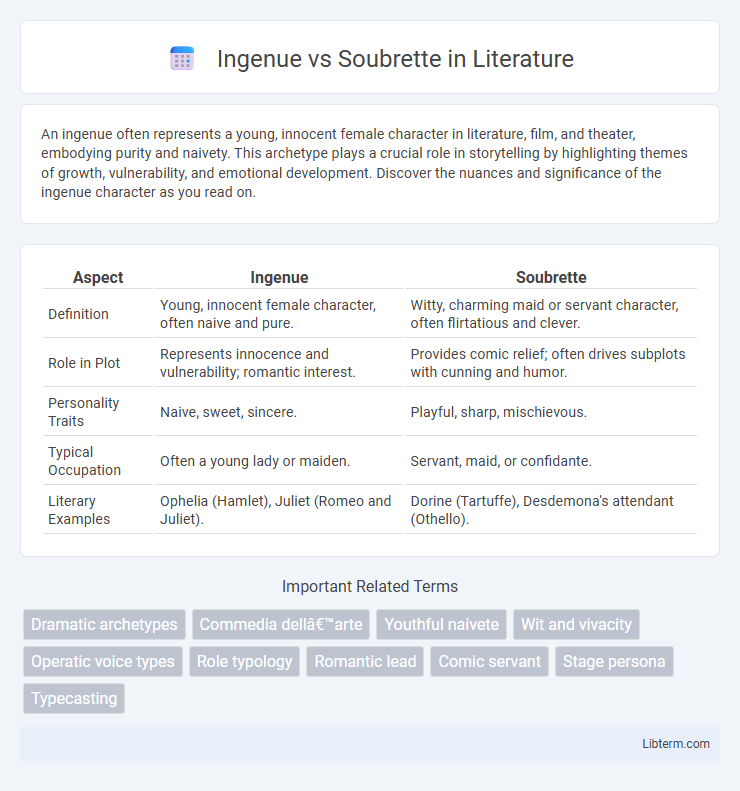An ingenue often represents a young, innocent female character in literature, film, and theater, embodying purity and naivety. This archetype plays a crucial role in storytelling by highlighting themes of growth, vulnerability, and emotional development. Discover the nuances and significance of the ingenue character as you read on.
Table of Comparison
| Aspect | Ingenue | Soubrette |
|---|---|---|
| Definition | Young, innocent female character, often naive and pure. | Witty, charming maid or servant character, often flirtatious and clever. |
| Role in Plot | Represents innocence and vulnerability; romantic interest. | Provides comic relief; often drives subplots with cunning and humor. |
| Personality Traits | Naive, sweet, sincere. | Playful, sharp, mischievous. |
| Typical Occupation | Often a young lady or maiden. | Servant, maid, or confidante. |
| Literary Examples | Ophelia (Hamlet), Juliet (Romeo and Juliet). | Dorine (Tartuffe), Desdemona's attendant (Othello). |
Understanding the Ingenue: Definition and Traits
The ingenue is a youthful, innocent female character often portrayed as naive and pure, embodying qualities like sincerity and vulnerability. Typically seen in literature, theater, and film, the ingenue's traits include wide-eyed curiosity, emotional openness, and a gentle demeanor. This archetype contrasts with the soubrette, who is characterized by vivacity, wit, and a playful or mischievous nature.
The Soubrette Archetype: Characteristics and Appeal
The Soubrette archetype embodies a lively, witty, and flirtatious young woman often seen in comedic roles, distinguished by her quick timing, charm, and playful demeanor. This character is typically a maid or servant who uses cleverness and mischievousness to influence the narrative and entertain audiences. The appeal of the soubrette lies in her vibrant energy, confident independence, and ability to subvert social norms through humor and cunning, contrasting the innocence of the ingenue.
Historical Origins of Ingenue and Soubrette Roles
The ingenue role originated in 18th-century French theater, embodying the innocent, youthful female character often portrayed as naive and pure, reflecting societal ideals of femininity during that era. The soubrette role also traces back to French comedy of the same period, characterized by a clever, witty maidservant who often drives the plot with her cunning and charm. Both roles evolved from commedia dell'arte traditions, where distinct character archetypes symbolized varying social statuses and personality traits, shaping their enduring presence in theater and opera.
Key Differences Between Ingenue and Soubrette Characters
Ingenue characters are typically portrayed as innocent, youthful, and naive, embodying purity and honesty, whereas soubrette roles are characterized by their flirtatious, witty, and mischievous nature, often serving as clever servants or confidantes. Ingenues usually experience emotional vulnerability and romantic idealism, contrasting with the soubrette's practical, street-smart attitude and quick wit. These distinctions affect their costume design, dialogue delivery, and narrative function, defining the ingenue as a symbol of hope and virtue, while the soubrette embodies humor and social savvy.
Notable Ingenue and Soubrette Performances in Theatre
Notable ingenue performances in theatre include Audrey Hepburn's role as Gigi in the 1951 production and Laura Linney's portrayal of Mary Tyrone in Long Day's Journey Into Night, showcasing innocence and youthful vulnerability. Soubrette roles feature memorable performances like Sutton Foster's Dolly Levi in "Hello, Dolly!" and Angela Lansbury's Mrs. Lovett in "Sweeney Todd," highlighting wit, charm, and coquettishness. These characters often serve as crucial narrative pivots, blending youthful innocence or playful cunning to enrich theatrical storytelling.
Ingenue vs. Soubrette: Voice and Acting Styles
Ingenue roles require a light, clear soprano voice that conveys youth and innocence, paired with acting that emphasizes naivety and vulnerability. Soubrette characters demand a brighter, more agile soprano with a coquettish tone, coupled with energetic, witty, and flirtatious acting. The distinction lies in the ingenue's portrayal of purity and sincerity versus the soubrette's vivaciousness and playful charm.
Evolution of Female Archetypes in Drama and Cinema
The evolution of female archetypes in drama and cinema is exemplified by the shift from the ingenue--often depicted as innocent, naive, and pure--to the soubrette, characterized by wit, charm, and a mischievous spirit. Early 20th-century films and theatrical works favored the ingenue as the idealized young woman, reflecting societal expectations of purity and virtue, whereas the soubrette emerged prominently in musical theater and comedies, representing a more liberated, playful feminine identity. This transition highlights broader cultural changes in gender roles and female representation, shaping the portrayal of women as complex, multifaceted characters rather than one-dimensional symbols.
Cultural Impact of Ingenue and Soubrette Portrayals
Ingenue and soubrette portrayals have significantly shaped cultural narratives around femininity and social roles, with ingenues often symbolizing innocence and idealized youth in literature and theater, reflecting societal expectations of purity and vulnerability. Soubrettes, characterized by their cleverness and flirtatiousness, challenge traditional gender norms by embodying wit and independence, contributing to evolving representations of female agency in performance arts. These archetypes continue to influence modern media, highlighting enduring cultural dialogues about identity, power, and gender dynamics.
Choosing Between Ingenue and Soubrette in Casting
Choosing between ingenue and soubrette roles in casting hinges on character traits and vocal qualities; ingenues typically embody youthful innocence and vulnerability, requiring a pure, lyrical soprano voice, while soubrettes portray lively, witty, and flirtatious characters with a light, agile vocal style. Consider the actor's age, demeanor, and ability to convey naivete versus playful cunning to ensure an authentic portrayal. Matching the singer's vocal timbre and acting strengths to the role enhances production quality and audience engagement.
The Future of Ingenue and Soubrette Roles in Modern Media
Ingenue and soubrette roles continue to evolve in modern media, reflecting shifts in cultural norms and audience expectations. The ingenue, traditionally characterized by innocence and naivety, is increasingly portrayed with greater complexity, showcasing empowerment and nuanced character development. Soubrette roles, known for their witty and playful traits, are expanding to highlight multidimensional personas, blending humor with depth to resonate with contemporary viewers.
Ingenue Infographic

 libterm.com
libterm.com